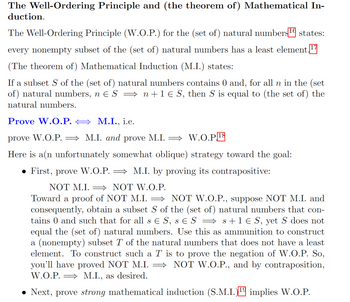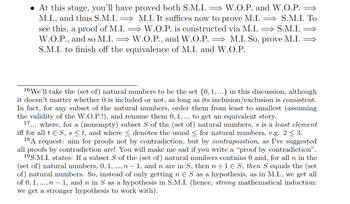
Advanced Engineering Mathematics
10th Edition
ISBN: 9780470458365
Author: Erwin Kreyszig
Publisher: Wiley, John & Sons, Incorporated
expand_more
expand_more
format_list_bulleted
Question
The numbers in the red box will have annotations below

Transcribed Image Text:The Well-Ordering Principle and (the theorem of) Mathematical In-
duction.
The Well-Ordering Principle (W.O.P.) for the (set of) natural numbers states:
every nonempty subset of the (set of) natural numbers has a least element 17
(The theorem of) Mathematical Induction (M.I.) states:
If a subset S of the (set of) natural numbers contains 0 and, for all n in the (set
of) natural numbers, n € S ⇒ n+ 1 € S, then S is equal to (the set of) the
natural numbers.
Prove W.O.P.
M.I., i.e.
prove W.O.P. ⇒ M.I. and prove M.I. W.O.P¹8
Here is a(n unfortunately somewhat oblique) strategy toward the goal:
● First, prove W.O.P. ⇒ M.I. by proving its contrapositive:
NOT M.I.
NOT W.O.P.
Toward a proof of NOT M.I. ⇒ NOT W.O.P., suppose NOT M.I. and
consequently, obtain a subset S of the (set of) natural numbers that con-
tains 0 and such that for all s € S, s € S ⇒ s + 1 € S, yet S does not
equal the (set of) natural numbers. Use this as ammunition to construct
a (nonempty) subset T of the natural numbers that does not have a least
element. To construct such a T is to prove the negation of W.O.P. So,
you'll have proved NOT M.I. ⇒ NOT W.O.P., and by contraposition,
W.O.P. M.I., as desired.
• Next, prove strong mathematical induction (S.M.I.) implies W.O.P.
19

Transcribed Image Text:• At this stage, you'll have proved both S.M.I. ⇒ W.O.P. and W.O.P. ⇒
M.I., and thus S.M.I. ⇒ M.I. It suffices now to prove M.I. ⇒ S.M.I. To
see this, a proof of M.I.W.O.P. is constructed via M.I.
⇒S.M.I.
W.O.P., and so M.I.W.O.P., and W.O.P. = M.I. So, prove M.I.
S.M.I. to finish off the equivalence of M.I. and W.O.P.
16 We'll take the (set of) natural numbers to be the set {0, 1, ...} in this discussion, although
it doesn't matter whether 0 is included or not, as long as its inclusion/exclusion is consistent.
In fact, for any subset of the natural numbers, order them from least to smallest (assuming
the validity of the W.O.P.!), and rename them 0, 1, ... to get an equivalent story.
17 where, for a (nonempty) subset S of the (set of) natural numbers, s is a least element
iff for all t € S, s ≤ t, and where ≤ denotes the usual ≤ for natural numbers, e.g. 2 ≤ 3.
18 A request: aim for proofs not by contradiction, but by contraposition, as I've suggested
all proofs by contradiction are! You will make me sad if you write a "proof by contradiction”.
19S.M.I. states: If a subset S of the (set of) natural numbers contains 0 and, for all n in the
(set of) natural numbers, 0, 1, ..., n - 1, and n are in S, then n+1 € S, then S equals the (set
of) natural numbers. So, instead of only getting n € S as a hypothesis, as in M.I., we get all
of 0, 1,..., n - 1, and n in S as a hypothesis in S.M.I. (hence, strong mathematical induction:
we get a stronger hypothesis to work with).
Expert Solution
This question has been solved!
Explore an expertly crafted, step-by-step solution for a thorough understanding of key concepts.
Step by stepSolved in 3 steps with 4 images

Knowledge Booster
Similar questions
arrow_back_ios
arrow_forward_ios
Recommended textbooks for you
 Advanced Engineering MathematicsAdvanced MathISBN:9780470458365Author:Erwin KreyszigPublisher:Wiley, John & Sons, Incorporated
Advanced Engineering MathematicsAdvanced MathISBN:9780470458365Author:Erwin KreyszigPublisher:Wiley, John & Sons, Incorporated Numerical Methods for EngineersAdvanced MathISBN:9780073397924Author:Steven C. Chapra Dr., Raymond P. CanalePublisher:McGraw-Hill Education
Numerical Methods for EngineersAdvanced MathISBN:9780073397924Author:Steven C. Chapra Dr., Raymond P. CanalePublisher:McGraw-Hill Education Introductory Mathematics for Engineering Applicat...Advanced MathISBN:9781118141809Author:Nathan KlingbeilPublisher:WILEY
Introductory Mathematics for Engineering Applicat...Advanced MathISBN:9781118141809Author:Nathan KlingbeilPublisher:WILEY Mathematics For Machine TechnologyAdvanced MathISBN:9781337798310Author:Peterson, John.Publisher:Cengage Learning,
Mathematics For Machine TechnologyAdvanced MathISBN:9781337798310Author:Peterson, John.Publisher:Cengage Learning,


Advanced Engineering Mathematics
Advanced Math
ISBN:9780470458365
Author:Erwin Kreyszig
Publisher:Wiley, John & Sons, Incorporated

Numerical Methods for Engineers
Advanced Math
ISBN:9780073397924
Author:Steven C. Chapra Dr., Raymond P. Canale
Publisher:McGraw-Hill Education

Introductory Mathematics for Engineering Applicat...
Advanced Math
ISBN:9781118141809
Author:Nathan Klingbeil
Publisher:WILEY

Mathematics For Machine Technology
Advanced Math
ISBN:9781337798310
Author:Peterson, John.
Publisher:Cengage Learning,

